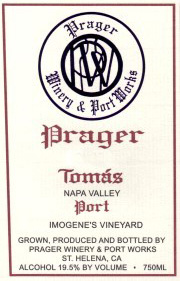

Prager Winery & Port Works
2004 Tomas Port, Imogene’s Vineyard(Napa Valley)
Prager is one of the few Napa Valley producers growing Portuguese varieties in the Valley. While the Port works, south of St. Helena, has been making sweet wine since 1980, the family has only begun making some of their Ports from traditional Portuguese grapes in the last two years.
When the Pragers purchased a vineyard north of Calistoga in 1999, they planted five traditional Port varieties, including the three for this wine – Touriga Nacional, Tinta Cao and Tinta Roriz. Curiously, there’s a bit of bacon in the nose, but on the palate, the wine is deliciously decadent with dark chocolate and raisin qualities to the fruit. Overall, this thick elixir is in good balance.
The wine was aged for two years in used oak barrels. The residual sugar is 8.4 percent, the alcohol – fortified with brandy brought from the Central Valley – is 19.5 percent, and there were 744 cases produced.
Reviewed March 23, 2007 by Alan Goldfarb.
Other reviewed wines from Prager Winery & Port Works
|
Prager Winery & Port Works 2003 Royal Escort Vintage Port, Paladini Vineyard (Napa Valley)Alan Goldfarb 3/23/2007 |
|
Prager Winery & Port Works NV Noble Companion Tawny, Priest Ranch (Napa Valley)Alan Goldfarb 3/23/2007 |
The Wine
Winery: Prager Winery & Port Works |
The Reviewer Alan Goldfarb
Alan Goldfarb
Alan Goldfarb has been writing about and reviewing wine for 17 years. His reviews have been published in the St. Helena Star, San Jose Mercury, San Francisco Examiner, Decanter, and Wine Enthusiast, among others. Not once has he used a point system, star system, or an iconic symbol to quantify a wine. What counts in Mr. Goldfarb’s criteria when judging a wine is: how it tastes in the glass; is it well-constructed; its food compatibility; and presence of redeeming regional attributes. |












